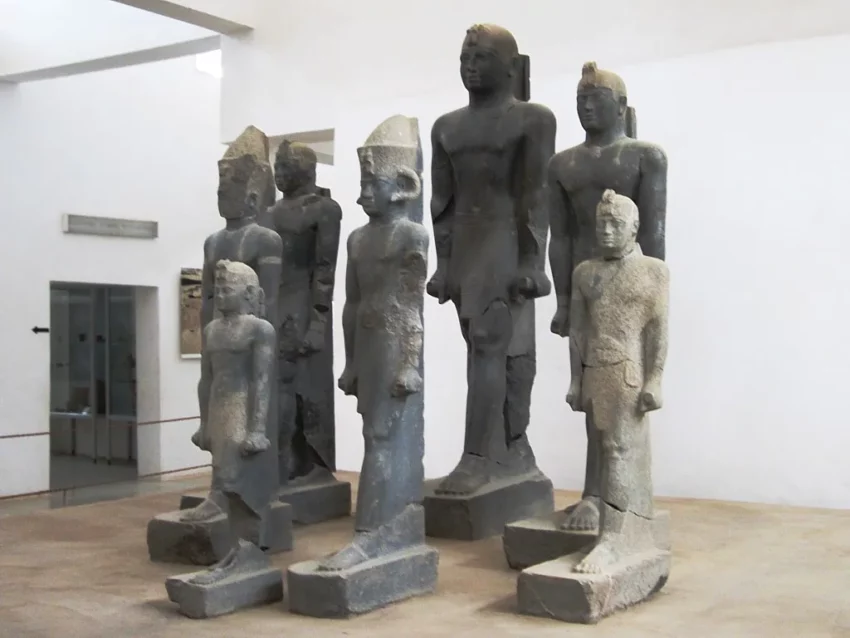Doukki Gel is an archaeological site located in Nubia, near the modern city of Kerma in Sudan. It is a significant site that dates back to the Kerma culture, which thrived around 2500 to 1500 BC. The site has revealed extensive information about the ancient Nubian civilization, including monumental structures, tombs, and living quarters. Doukki Gel has been instrumental in understanding the political and cultural dynamics of ancient Nubia and its interactions with neighboring Egypt.
Get your dose of History via Email
Historical Background of Doukki Gel
The discovery of Doukki Gel dates back to 2003 when a Swiss archaeological team led by Charles Bonnet unearthed the site. The team found evidence of a large urban center that was previously unknown. Doukki Gel was built by the Nubian Kerma culture, which is known for its unique social and political structures. The site later became an important hub during the Kingdom of Kush, which succeeded the Kerma culture.
Archaeological findings suggest that Doukki Gel was a bustling metropolis with a complex urban layout. It was inhabited by a sophisticated society that engaged in extensive trade and had strong political influence. The city’s strategic location near the Nile River contributed to its significance in the region. Over time, Doukki Gel witnessed various cultural and political changes, including interactions with ancient Egypt.
One of the most remarkable aspects of Doukki Gel is the presence of large, deffufa-like structures. These mud-brick buildings are similar to the ones found in Kerma, indicating a continuity of architectural traditions. The site also contains evidence of temples and palaces, suggesting that it was a center of power and religious activity.
Throughout its history, Doukki Gel has seen different phases of occupation. After the decline of the Kerma culture, the site continued to be important during the Kushite period. It was during this time that Doukki Gel may have served as a royal city for the Kushite kings, before the rise of the more famous Meroitic civilization.
Historically, Doukki Gel has also been the scene of significant events. It is believed to have played a role in the power struggles between Nubia and Egypt. The site provides valuable insights into the cultural exchanges and conflicts that shaped the history of the Nile Valley.
About Doukki Gel
Doukki Gel is characterized by its vast mud-brick structures, which are indicative of the architectural prowess of the Kerma culture. The site encompasses a large area with evidence of urban planning, including residential areas, public spaces, and administrative buildings. The use of mud bricks in construction was a common practice in Nubia, providing durability in the harsh climate.
The central feature of Doukki Gel is the presence of monumental structures known as deffufas. These are large, flat-topped mounds that were likely used for religious or ceremonial purposes. The largest deffufa at Doukki Gel is comparable in size to the Western Deffufa in Kerma, which stands as one of the largest known mud-brick buildings in the world.
Excavations at Doukki Gel have also uncovered tombs that provide insights into the burial customs of the Kerma culture. These tombs often contained a rich array of grave goods, including pottery, jewelry, and other artifacts. The presence of such items suggests a belief in an afterlife and the importance of the deceased in society.
Archaeologists have also found evidence of industrial activities at Doukki Gel, such as metalworking and pottery production. These findings point to a complex economy that supported the city’s inhabitants. The quality and diversity of the artifacts suggest that Doukki Gel was a center of craftsmanship and innovation.
The layout of Doukki Gel reveals a hierarchical society with a clear distinction between elite and commoner areas. The larger and more elaborate structures are believed to have been occupied by the ruling class, while simpler dwellings housed the general population. This spatial organization reflects the social stratification that was prevalent in Nubian societies.
Theories and Interpretations
Several theories have emerged regarding the purpose and significance of Doukki Gel. Some scholars believe that the site was a religious and political capital of the Kerma culture, reflecting its power and influence. The grandeur of the deffufas supports this theory, as they are often associated with elite and ceremonial functions.
There is also speculation about the relationship between Doukki Gel and ancient Egypt. The site’s proximity to Egypt and the presence of Egyptian artifacts suggest a degree of cultural exchange. Some theories propose that Doukki Gel may have been a frontier settlement that played a role in the trade and diplomatic relations between the two civilizations.
The mysteries of Doukki Gel extend to the interpretation of its art and iconography. The artifacts found at the site display a mix of indigenous and foreign influences, which has led to debates about the extent of cultural assimilation and identity in ancient Nubia.
Dating of the site has been carried out using various methods, including radiocarbon dating and stratigraphic analysis. These techniques have helped establish a timeline for the occupation and development of Doukki Gel, although some periods remain less understood due to gaps in the archaeological record.
Theories about Doukki Gel continue to evolve as new discoveries are made. Ongoing excavations and research are essential for a deeper understanding of the site’s history and its role in the broader context of Nubian and African archaeology.
At a glance
Country: Sudan
Civilization: Kerma culture, later Kingdom of Kush
Age: Approximately 2500 to 1500 BC (Kerma culture), followed by subsequent Kushite occupation
Conclusion and Sources
Reputable sources used in the creation of this article include:

